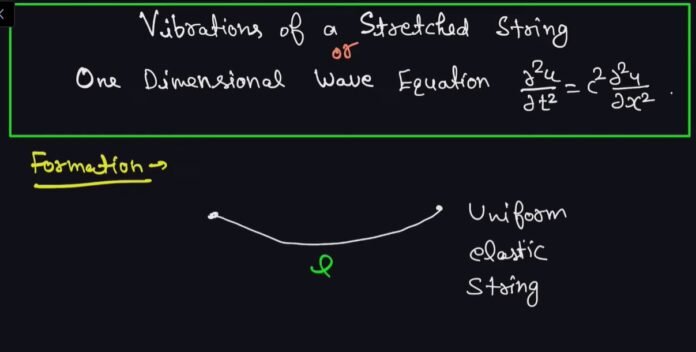There are various examples of waves, such as sound waves, ocean waves, radio waves or vibrations that are produced by musical instruments as well as electromagnetic radiation producing waves.
- In physics, a single disturbance is called a pulse whereas a repetitive disturbance is called a periodic wave and a one-dimensional wave as the name suggests prescribes its own space dimension, i.e., the only independent variable present is time in this case.
What is a Wave?
A wave is a disturbance in a medium that carries energy without a net movement of the particles and usually involves a periodic, repetitive motion.
For example, if we make a call to a friend in another city with our mobile phone, the entire communication happens via audio but the entire process of transmission of a signal from the speaker to the receiver occurs as a waveform. The mobile phone converts sound energy into an electrical signal which then propagates either through copper wires or through antennae in wireless communication.
Types of Waves
Waves around us can be sound waves, water waves, sine waves, radio waves, slinky waves, cosine waves, string waves, etc.
These are created through disturbance and there are following three types of waves:
Mechanical Waves:
These are generated as the propagation of a disturbance through the material medium owing to the repeated periodic movement of the particles of the medium about their mean positions and the disturbance being handed over from one particle to the other in the medium.
Momentum and energy propagate by the movement of particles of the material medium but the medium remains at the previous position and the mass transfer is not possible to take place here.
- The propagation can take place because of the inertia and elastic properties of the material medium and these waves cannot travel through the vacuum.
Electromagnetic waves:
Electromagnetic waves consist of waves of the electromagnetic field, which propagate through space and carry electromagnetic radiant energy and momentum. It includes radio waves, microwaves, infrared, light, and UV i.e., ultraviolet rays, X-rays, and gamma rays.
- Microwaves (like the ones used in microwave ovens in our homes) are a subsection of the radio wave segment of the EM spectrum.
Matter waves:
Matter waves: According to De-Broglie, a wave associated with each moving particle is called a matter wave and this wave has wave length λ=hpλ=hp, where h is Planck’s constant and p is the momentum of the moving particle.
Characteristics of Matter waves:
The lighter the particle, the greater the De-Broglie wavelength associated with them and the faster the particle moves, the smaller its De-Broglie wavelength.
- The matter waves are not electromagnetic in nature and are produced only by a charged particle.
Derivation of the One-Dimensional Wave Equation
Consider the relation between Newton’s law and volume V that is in the direction x:
△F= (△mdvx)/dt (Newton’s law)
Where F is the force acting on the element with volume ΔV.
△Fx= −△px△Sx = ( (∂p△x)/∂x+ ∂pdt/∂x) △Sx≃−△V∂p/∂p∂x−△∂p/∂p∂x= Mdvx/dt
As dt is small, it is not considered, and ΔSx is in the x-direction, so, ΔyΔz and from Newton’s law
= (ρ△Vdvx)/dt
From
dvx/dt as ∂vx/dt
dvx/dt=∂vx/∂dt+vx ∂vx/∂t ≈ ∂vx/∂t
– ∂p/∂t = ρ dvx/dt
This is the equation of motion.
Now combine the conservation of mass and the equation of motion and we let the operator (∂/∂x) work on the equation of motion:
-∂/∂x ∂p/∂x = -∂/∂x ρ ∂vx/∂t
= ρ ∂/∂t ∂vx/∂x
〖∂p〗^2 /(∂x^2 )- ρ/K (∂^2 p)/(∂t^2 ) = 0
K= bulk modulus
Rewriting the above equation, we get:
(∂^2 u(x,t))/(∂x^2 )- (〖1∂〗^2 u(x,t))/(c v^2 〖∂t〗^2 )
Here c is the sound and is given by
c= √(K/ρ)
where, K is the bulk modulus.
Recommended Articles:
Derivation Of Law Of Conservation Of Momentum
Derivation Of Lens Formula
Derivation Of Lens Maker Formula: Assumptions, Derivation, Applications, And Limitations
Derivation Of Lorentz Transformation: Introduction, Formula, Transformation, And significance
Derivation of Mirror Formula: Terms, Formula, Assumptions, And Derivation
Waves are of three types namely Mechanical waves, Electromagnetic waves, and Matter waves. Electromagnetic waves are also called electromagnetic radiations and includes radio waves, microwaves, infrared, light, and UV i.e., ultraviolet rays, X-rays, and gamma rays. The equation of the wave is y = A sin(ωt−kx) where y denotes the displacement, A is amplitude, the maximum displacement on either side, ω is the angular frequency given by 2πT=2πf, f is the frequency, T is the time period, and k is a constant which is equal to 2πλ , where λ is the wavelength. The lighter the particle, the greater the De-Broglie wavelength associated with them and the faster the particle moves, the smaller its De-Broglie wavelength. Electromagnetic waves were first postulated by James Clerk Maxwell and subsequently confirmed by Heinrich Hertz. Derivation of the One-Dimensional Wave Equation FAQs
What are the types of waves?
What are different types of electromagnetic waves?
Define wave equation.
Write any two characteristics of matter waves.
Who postulated the electromagnetic waves first?
